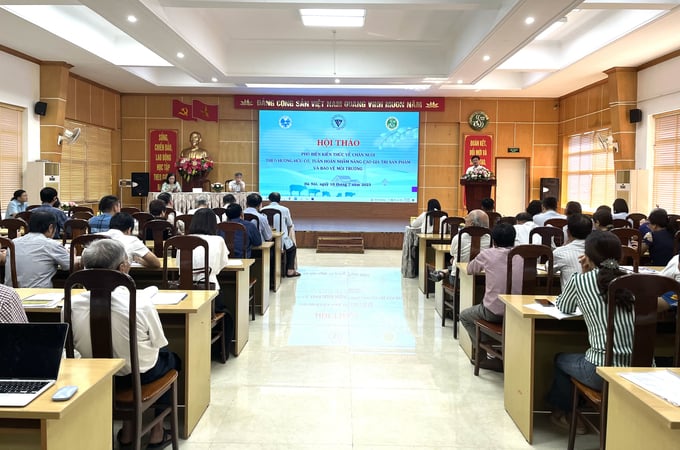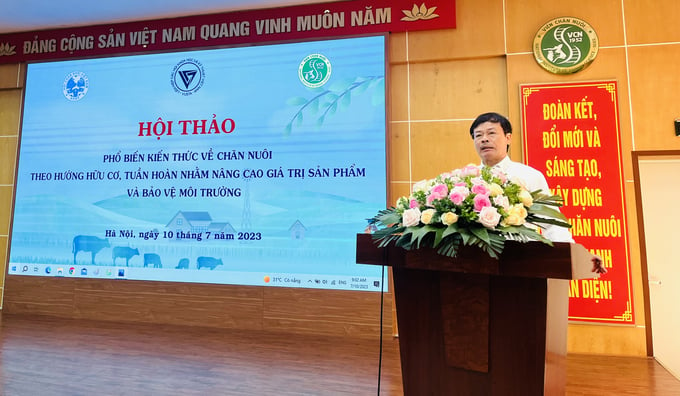November 27, 2025 | 00:13 GMT +7
November 27, 2025 | 00:13 GMT +7
Hotline: 0913.378.918
November 27, 2025 | 00:13 GMT +7
Hotline: 0913.378.918

The Seminar on “disseminating knowledge on livestock production in the organic and circular direction in order to improve product value and protect the environment” took place on July 10 at the National Institute of Animal Science. Photo: Hong Tham.
On July 10 in Hanoi, the National Institute of Animal Science in collaboration with the Animal Husbandry Association of Vietnam (AHAV) organized the Seminar on “disseminating knowledge on livestock production in the organic and circular direction in order to improve product value and protect the environment”.
According to the Department of Livestock Production, besides the achieved results, every year the livestock industry generates a large amount of waste into the environment. In the period 2018 - 2022, each year, over 60 million tons of manure and over 304 million m3 of wastewater were discharged from the main livestock species. The industry needs to find a way to treat and reuse waste to reduce greenhouse gas emissions, thus protecting the livestock environment.
Of the 60 million tons of manure produced by major livestock, 40% is from cows, 34% from pigs, 21% from buffalo and 6% from poultry. Of the 304 million m3 of wastewater, over 84% comes from pig farming. Only a part of it is treated as organic fertilizer, an input for a biogas plant system to create renewable energy, or a source of insect rearing that provides high-quality protein as animal feed and organic fertilizers. The larger part of the waste is discharged into the environment causing negative impacts on the environment.
Nguyen Xuan Duong, Chairman of the Animal Husbandry Association of Vietnam, said, “Our country's livestock industry has maintained its growth for many years, but still faces many difficulties. For sustainable development, it is impossible not to apply livestock in the circular direction”.

Nguyen Xuan Duong, Chairman of the Animal Husbandry Association of Vietnam, said that circular livestock production is an inevitable trend. Photo: Hong Tham.
Nguyen Anh Phong, Director of the Information Center for Agriculture and Rural Development (Institute of Policy and Strategy for Agriculture and Rural Development) said that in order to minimize the negative impacts of livestock production on the environment, many models developed in the direction of the circular economy have been applied, such as: Garden - pond - barn; 4F biosafety livestock (Farm - Food - Feed - Fertilizer); Green circular models; Circular beef cattle farming model.
Models applying scientific, technical, biotechnological, and physicochemical technologies to increase product value, and reduce the generation of by-products and waste include: Biogas model, the model using biological buffers in livestock production, the model of using livestock waste to raise insects such as composting worms and black soldier fly.
“The circular economy models help to make full use of agricultural by-products, minimize environmental exploitation, and make the most of natural resources. Thanks to them farmers can minimize the amount of waste and emissions released into the environment, thus making a contribution to the implementation of the Government of Vietnam’s commitment at COP26 on reducing greenhouse gas emissions with the goal of achieving net zero emissions by 2050,” said Director Phong.
According to Ha Van Thang, Chairman of the Vietnam Council of Agricultural Enterprises, agroproduction in Vietnam still mainly focuses on productivity and output, following linear thinking. The industry has not prioritized the demand for sustainable, environment-friendly development, not paying attention to the excess of the production process. As a result, the situation of wasting agricultural by-products and livestock waste is common, even causing pollution to the environment.
The development of circular livestock production is an inevitable trend. But because this is a new development model, with wide linkages, with the participation of many subjects, it requires effort and responsibility of the authorities at all levels. Chairman Thang believed that the industry needs people who are really responsible, have aspirations for the development of the locality, people who dare to think, dare to act and are “willing to eat and work together” with farmers.
“Businesses and people taking the lead in this process will face many challenges. This is the time when the support, sharing and cooperation of local authorities are needed. Only then can the goal of developing livestock in general and cattle in particular based on the circular economy be achieved," said Ha Van Thang, Chairman of the Vietnam Council of Agricultural Enterprises.
Translated by Samuel Pham
/2025/11/26/4909-2-154329_878.jpg)
(VAN) Pearl grouper farming in HDPE cages not only delivers economic efficiency but also contributes to protecting the environment, creating jobs, and promoting marine-based experiential tourism.

(VAN) The model of making a living under the forest canopy through the agroforestry system in Van Son commune, Bac Ninh province, is expected to generate an annual income of approximately VND 30 million/ha.

(VAN) Many enterprises in Can Tho are harnessing natural energy and reducing greenhouse gas emissions in their production processes, thereby contributing to the promotion of a sustainable green transition.
/2025/11/24/3536-2-112800_176.jpg)
(VAN) Dong Nai now has tens of thousands of hectares of forests certified for sustainable management, and this area will continue to be expanded in the coming period.

(VAN) Vinh Ha hamlet (Dai Xuyen commune, Hanoi) is shifting away from small-scale farming as households adopt bioscurity into their breeder chicken models.

(VAN) Heavy rains make aquatic species more vulnerable to disease. Proactive water management and high-tech systems help farmers prevent outbreaks and protect yields.

(VAN) Greenhouses are shifting production mindsets in Binh Lu commune, enabling farmers to ‘weather the sun and rain’ and secure stable vegetable harvests throughout the year.